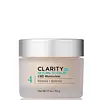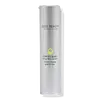What's inside
What's inside
 Key Ingredients
Key Ingredients

 Benefits
Benefits

 Concerns
Concerns

 Ingredients Side-by-side
Ingredients Side-by-side

Water
Skin ConditioningAloe Barbadensis Leaf Juice
Skin ConditioningCaprylic/Capric Triglyceride
MaskingStearic Acid
CleansingCetyl Alcohol
EmollientGlyceryl Stearate Citrate
EmollientGlycerin
HumectantCannabidiol - Synthetically Produced
AntioxidantCannabis Sativa Seed Oil
EmollientCannabis Sativa Seed Extract
EmollientCannabis Sativa Flower/Leaf/Stem Extract
AntioxidantArnica Montana Flower Extract
MaskingPinus Pinaster Bark Extract
AntioxidantNiacinamide
SmoothingSimmondsia Chinensis Seed Oil
EmollientCamellia Sinensis Leaf Extract
AntimicrobialChamomilla Recutita Flower Extract
MaskingPanthenol
Skin ConditioningGlyceryl Stearate
EmollientTocopheryl Acetate
AntioxidantAllantoin
Skin ConditioningXanthan Gum
EmulsifyingDimethicone
EmollientCoco-Caprylate
EmollientCetearyl Alcohol
EmollientLeuconostoc/Radish Root Ferment Filtrate
AntimicrobialCetearyl Glucoside
EmulsifyingCitric Acid
BufferingSodium Benzoate
MaskingSodium Hydroxide
BufferingPotassium Sorbate
PreservativePhenoxyethanol
PreservativeEthylhexylglycerin
Skin ConditioningWater, Aloe Barbadensis Leaf Juice, Caprylic/Capric Triglyceride, Stearic Acid, Cetyl Alcohol, Glyceryl Stearate Citrate, Glycerin, Cannabidiol - Synthetically Produced, Cannabis Sativa Seed Oil, Cannabis Sativa Seed Extract, Cannabis Sativa Flower/Leaf/Stem Extract, Arnica Montana Flower Extract, Pinus Pinaster Bark Extract, Niacinamide, Simmondsia Chinensis Seed Oil, Camellia Sinensis Leaf Extract, Chamomilla Recutita Flower Extract, Panthenol, Glyceryl Stearate, Tocopheryl Acetate, Allantoin, Xanthan Gum, Dimethicone, Coco-Caprylate, Cetearyl Alcohol, Leuconostoc/Radish Root Ferment Filtrate, Cetearyl Glucoside, Citric Acid, Sodium Benzoate, Sodium Hydroxide, Potassium Sorbate, Phenoxyethanol, Ethylhexylglycerin
Pyrus Malus Juice
Skin ConditioningVitis Vinifera Juice
AntioxidantAloe Barbadensis Leaf Juice
Skin ConditioningCaprylic/Capric Triglyceride
MaskingHelianthus Annuus Seed Oil
EmollientGlyceryl Stearate
EmollientStearyl Alcohol
EmollientCetyl Alcohol
EmollientDiheptyl Succinate
EmollientCapryloyl Glycerin
Palmitoyl Tripeptide-5
Skin ConditioningGlycerin
HumectantStearic Acid
CleansingGlyceryl Stearate Citrate
EmollientPullulan
Acetyl Hexapeptide-8
HumectantMalus Domestica Fruit Cell Culture Extract
Skin ConditioningVitis Vinifera Fruit Cell Extract
Skin ConditioningCitrus Limon Leaf Cell Extract
Skin ConditioningBorago Officinalis Seed Oil
EmollientLinum Usitatissimum Seed Oil
PerfumingRosa Canina Fruit Oil
EmollientCamellia Sinensis Leaf Extract
AntimicrobialCalendula Officinalis Flower Extract
MaskingLavandula Angustifolia Extract
Skin ConditioningArnica Montana Flower Extract
MaskingVitis Vinifera Seed Oil
EmollientLonicera Caprifolium Extract
AstringentAlgae Extract
EmollientSqualane
EmollientPanthenol
Skin ConditioningMagnesium Ascorbyl Phosphate
AntioxidantTocopherol
AntioxidantCitrus Medica Limonum Peel Extract
EmollientButyrospermum Parkii Butter
Skin ConditioningEthylhexylglycerin
Skin ConditioningMenthol
MaskingAllantoin
Skin ConditioningXanthan Gum
EmulsifyingSodium Phytate
Methyl Lactate
PerfumingCaprylyl Glycol
EmollientLitsea Cubeba Fruit Oil
MaskingWater
Skin ConditioningCinnamomum Camphora Oil
MaskingEthyl Linalool
MaskingCitral
PerfumingLimonene
PerfumingPyrus Malus Juice, Vitis Vinifera Juice, Aloe Barbadensis Leaf Juice, Caprylic/Capric Triglyceride, Helianthus Annuus Seed Oil, Glyceryl Stearate, Stearyl Alcohol, Cetyl Alcohol, Diheptyl Succinate, Capryloyl Glycerin, Palmitoyl Tripeptide-5, Glycerin, Stearic Acid, Glyceryl Stearate Citrate, Pullulan, Acetyl Hexapeptide-8, Malus Domestica Fruit Cell Culture Extract, Vitis Vinifera Fruit Cell Extract, Citrus Limon Leaf Cell Extract, Borago Officinalis Seed Oil, Linum Usitatissimum Seed Oil, Rosa Canina Fruit Oil, Camellia Sinensis Leaf Extract, Calendula Officinalis Flower Extract, Lavandula Angustifolia Extract, Arnica Montana Flower Extract, Vitis Vinifera Seed Oil, Lonicera Caprifolium Extract, Algae Extract, Squalane, Panthenol, Magnesium Ascorbyl Phosphate, Tocopherol, Citrus Medica Limonum Peel Extract, Butyrospermum Parkii Butter, Ethylhexylglycerin, Menthol, Allantoin, Xanthan Gum, Sodium Phytate, Methyl Lactate, Caprylyl Glycol, Litsea Cubeba Fruit Oil, Water, Cinnamomum Camphora Oil, Ethyl Linalool, Citral, Limonene
Ingredients Explained
These ingredients are found in both products.
Ingredients higher up in an ingredient list are typically present in a larger amount.
Allantoin is a soothing ingredient known for its protective and moisturizingg properties. Because of this, it is often added to products with strong active ingredients.
Studies show higher concentrations of this ingredient can promote wound healing.
Though it can be derived from the comfrey plant, allantoin is produced synthetically for cosmetic products to ensure purity.
Learn more about AllantoinAloe Barbadensis Leaf Juice comes from leaves of the aloe plant. Aloe Barbadensis Leaf Juice is best known for helping to soothe sunburns. It is also anti-inflammatory, moisturizing, antiseptic, and can help heal wounds.
Aloe is packed with good stuff including Vitamins A, C, and E. These vitamins are antioxidants, which help fight free-radicals and the damage they may cause. Free-radicals are molecules that may damage your skin cells, such as pollution.
Aloe Barbadensis Leaf Juice also contains sugars. These sugars come in the form of monosaccharides and polysaccharides, folic acid, and choline. These sugars are able to help bind moisture to skin.
It also contains minerals such as calcium, 12 anthraquinones, fatty acids, amino acids, and Vitamin B12.
Learn more about Aloe Barbadensis Leaf JuiceArnica Montana Flower is more commonly known as Wolf's Bane. While this flower has been used in traditional medicine, its skin benefits are in question.
The FDA considers Wolf's Bane to be an unsafe herb. They advise against taking it orally or applying it to broken skin.
Wolf's Bane has been said to have anti-inflammatory properties. However, studies are conflicting about whether this is true.
According to the Final report on the safety assessment of Arnica montana, this plant has not been found to cause dermal irritation.
This flower contains numerous fatty acids such as palmitic, linoleic, myristic, and linolenic acids. The presence and amount of fatty acids depends on where the flower is harvested.
Like other flowers, this ingredient has a natural fragrance. It can also be used to mask, or cover, the unpleasant scents from other ingredients.
Learn more about Arnica Montana Flower ExtractCamellia Sinensis Leaf Extract is derived from the leaves of the tea plant. Black tea, green tea, and oolong tea are all harvested from this plant.
This ingredient has many skin benefits:
This ingredient contains polyphenols, a strong antioxidant. Antioxidants help fight off molecules that damage skin cells.
On top of that, the antioxidants in green tea neutralize free-radicals from the sun. This gives the skin some extra UV protection, but should not replace sunscreen.
Many components of tea have anti-inflammatory properties.
Polyphenols and L-theanine help soothe the skin and reduce irritation. The caffeine in Camellia Sinensis Leaf Extract helps calm inflamed blood vessels.
Other compounds found in tea include: Vitamin Bs, linoleic acid, magnesium, calcium, iron, and zinc.
Research has shown both drinking Camellia Sinensis Leaf Tea and applying it to the skin can help boost skin elasticity and hydration. Studies also show using tea extract may reduce sebum, or oil, production.
Learn more about Camellia Sinensis Leaf ExtractThis ingredient is an emollient, solvent, and texture enhancer. It is considered a skin-softener by helping the skin prevent moisture loss.
It helps thicken a product's formula and makes it easier to spread by dissolving clumping compounds.
Caprylic Triglyceride is made by combining glycerin with coconut oil, forming a clear liquid.
While there is an assumption Caprylic Triglyceride can clog pores due to it being derived from coconut oil, there is no research supporting this.
Learn more about Caprylic/Capric TriglycerideCetyl Alcohol is a fatty alcohol. Fatty Alcohols are most often used as an emollient or to thicken a product.
Its main roles are:
Though it has "alcohol" in the name, it is not related to denatured alcohol or ethyl alcohol.
The FDA allows products labeled "alcohol-free" to have fatty alcohols.
Learn more about Cetyl AlcoholEthylhexylglycerin (we can't pronounce this either) is commonly used as a preservative and skin softener. It is derived from glyceryl.
You might see Ethylhexylglycerin often paired with other preservatives such as phenoxyethanol. Ethylhexylglycerin has been found to increase the effectiveness of these other preservatives.
Glycerin is already naturally found in your skin. It helps moisturize and protect your skin.
A study from 2016 found glycerin to be more effective as a humectant than AHAs and hyaluronic acid.
As a humectant, it helps the skin stay hydrated by pulling moisture to your skin. The low molecular weight of glycerin allows it to pull moisture into the deeper layers of your skin.
Hydrated skin improves your skin barrier; Your skin barrier helps protect against irritants and bacteria.
Glycerin has also been found to have antimicrobial and antiviral properties. Due to these properties, glycerin is often used in wound and burn treatments.
In cosmetics, glycerin is usually derived from plants such as soybean or palm. However, it can also be sourced from animals, such as tallow or animal fat.
This ingredient is organic, colorless, odorless, and non-toxic.
Glycerin is the name for this ingredient in American English. British English uses Glycerol/Glycerine.
Learn more about GlycerinGlyceryl Stearate is a mix of glycerin and stearic acid.
It is used to stabilize the mixing of water and oil ingredients. By preventing these ingredients from separating, it can help elongate shelf life. It can also help thicken the product's texture.
As an emollient, it helps soften skin and supports barrier-replenishing ingredients.
In cosmetics, Glyceryl Stearate is often made from vegetable oils or synthetically produced.
This ingredient may not be fungal-acne safe
Fun fact: The human body also creates Glyceryl Stearate naturally.
Learn more about Glyceryl StearateGlyceryl Stearate Citrate is a citric acid ester of glyceryl stearate.
It is an emulsifier, emollient, and a surfactant.
Emulsifiers help stabilize a product. It does this by preventing certain ingredients from separating. Common ingredients include oils and water, which do not mix naturally. Emulsifiers have properties that help keep ingredients such as these together.
Emollients help soothe and soften the skin. They do this by creating a protective film on your skin. This barrier helps trap moisture and keeps your skin hydrated. Emollients may be effective at treating dry or itchy skin.
Surfactants help gather oils, dirt, and other pollutants from the skin. This helps them to be easily rinsed away.
Learn more about Glyceryl Stearate CitratePanthenol is a common ingredient that helps hydrate and soothe the skin. It is found naturally in our skin and hair.
There are two forms of panthenol: D and L.
D-panthenol is also known as dexpanthenol. Most cosmetics use dexpanthenol or a mixture of D and L-panthenol.
Panthenol is famous due to its ability to go deeper into the skin's layers. Using this ingredient has numerous pros (and no cons):
Like hyaluronic acid, panthenol is a humectant. Humectants are able to bind and hold large amounts of water to keep skin hydrated.
This ingredient works well for wound healing. It works by increasing tissue in the wound and helps close open wounds.
Once oxidized, panthenol converts to pantothenic acid. Panthothenic acid is found in all living cells.
This ingredient is also referred to as pro-vitamin B5.
Learn more about PanthenolStearic Acid is a fatty acid. It is an emollient, emulsifier, and texture enhancer.
As an emollient, stearic acid helps soften skin. It aids the skin's protective barrier by preventing water loss. It also provides a gentle cleansing effect without stripping away natural oils.
Stearic acid may also be used to enhance the texture of products. It can add volume and stabilize ingredients such as water and oil. This can help water and oil ingredients from separating.
Sources of stearic acid include animal or vegetable fats/oils such as coconut or shea. It can be naturally found in butter, cocoa butter, shea butter, vegetable fats, and animal tallow.
This ingredient may not be Malassezia folliculitis, or fungal-acne safe.
Learn more about Stearic AcidWater. It's the most common cosmetic ingredient of all. You'll usually see it at the top of ingredient lists, meaning that it makes up the largest part of the product.
So why is it so popular? Water most often acts as a solvent - this means that it helps dissolve other ingredients into the formulation.
You'll also recognize water as that liquid we all need to stay alive. If you see this, drink a glass of water. Stay hydrated!
Learn more about WaterXanthan gum is used as a stabilizer and thickener within cosmetic products. It helps give products a sticky, thick feeling - preventing them from being too runny.
On the technical side of things, xanthan gum is a polysaccharide - a combination consisting of multiple sugar molecules bonded together.
Xanthan gum is a pretty common and great ingredient. It is a natural, non-toxic, non-irritating ingredient that is also commonly used in food products.
Learn more about Xanthan Gum